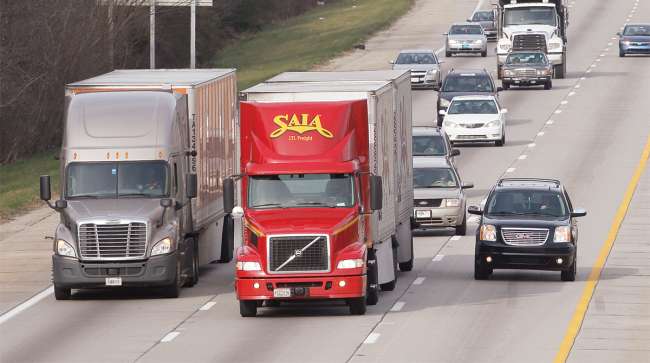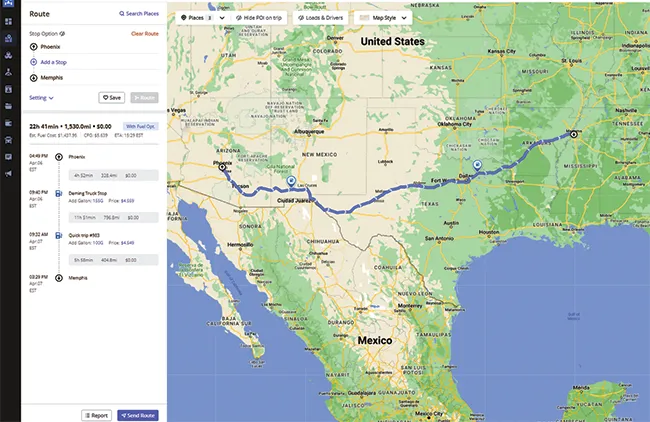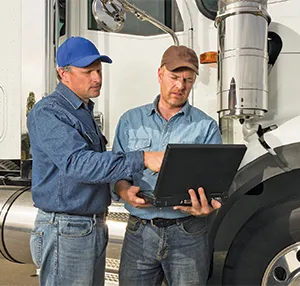Truck-Specific Navigation Software Offers Safety, Efficiency

[Stay on top of transportation news: Get TTNews in your inbox.]
As navigation and routing software applications grow more granular, developers are working to integrate pertinent data to support safe, efficient fleet operations.
However, some trucking operations question whether truck-specific or “truck-legal” navigation and routing systems are necessary, when consumer systems are readily available. But suppliers note that the value of truck-specific navigation and optimized routing is that the driver is receiving critical information when it is most needed.
“Real-time information is essential,” said Chris Oliver, chief marketing officer for Trucker Path. “Navigating on I-10 from L.A. to Jacksonville is one thing, but navigating through the streets of Boston is another.”
Trimble’s Rishi Mehra, vice president of product vision and experience, explained that the information must come at the right time and has to be actionable.
“[Developers and designers] put in a lot of thought to communicate to the driver the right information at the right time so that the driver does not mute the application or dismiss the application,” Mehra said.

Trucker Path’s app can navigate drivers by creating geofencing around shipping docks. (Trucker Path)
System providers said that more specific data enables them to provide more useful details to drivers and to back-office personnel, including dispatchers. The sources of the data include partnerships, such as one that Trimble Transportation formed with WeatherOptics to provide “hyperlocal” weather forecasting.
Trucker Path relies in part on its users — more than 1 million, Oliver said — for real-time inputs on a range of vital matters such as bridge heights, road and traffic conditions, helpful last-mile information, and parking availability.
“Who better to tell you the current situation on the road than a driver who’s there looking at it?” Oliver said. Trucker Path continually refines its information based on “crowdsourced data” from its driver-users, Oliver said. “If we thought the bridge was 15 feet and it’s only 14, they can tell us.”
The Trucker Path app is embedded in the Samsara system, providing information on truck stops, pricing and parking availability, Oliver said.
ProMiles’ mobile apps operate on iOS and Android smart devices, and fleet managers can activate the app within certain telematics/ELD providers, said Glenn Williams, executive vice president of sales and product management.

According to vendors, the trend is for navigation and route optimization to benefit many aspects of trucking operations. (shotbydave/Getty Images)
Integration offerings with existing fleet management systems can sometimes, but not always, be a challenge, Williams and some other vendors said. “All the telematics solutions are different,” Williams said. “In some cases, you can put your app on a telematics device out there and it’ll automatically work. Other cases, you have to get some IT resources involved to help, whether on the routing side or on the in-cab navigation side.”
Dwayne Lazarre, director of strategic accounts at Trimble Maps, explained in the company’s webinar presentation offerings such as measuring driver performance by comparing planned versus actual routes; maximizing revenue through reduced fuel and operating costs; and increasing fleet safety with real-time traffic and weather alerts.
OneRail, a last-mile delivery platform that maintains a courier network, is in a partnership with Trimble, said Eddie Misicka, vice president of product and solutions. Misicka said OneRail is working on “getting into some of these TMSes, and putting in this easy button, ‘Dispatch to OneRail.’ ”
In wholesale distribution, last mile logistics is a crucial touchpoint that strengthens our entire supply chain. However, challenges like high delivery failure costs and urban traffic lead to inefficiencies. To learn about ways to optimize read: https://t.co/hLAiuvgOHd#lastmile — OneRail (@OneRailapp) June 3, 2024
“Schneider actually uses us [for] the last part of the final-mile,” he said of the platform’s customer. “They’re going to move stuff as far as they want to move it from a Schneider [distribution center] or from one of their customers, then we can put it onto that smaller asset.”
Misicka added that OneRail is able to facilitate the best assets depending on the load. “If they’re deconsolidating and they just want to move smaller pieces from a trailer that’s the big value that they get,” he said, noting that OneRail just launched “Capacity Connect,” a program targeting that final segment.
In March, Walmart announced that it was making its proprietary Route Optimization software available to all businesses as a software-as-a-service solution through its Walmart Commerce Technologies entity.
The retailer, which ranks No. 2 on the Transport Topics Top 100 list of the largest private carriers in North America, said its Route Optimization “provides businesses of all sizes the use of AI-driven software to optimize driving routes, pack trailers efficiently and minimize miles traveled.” Walmart said that by using the technology, it “avoided 94 million pounds of CO² by eliminating 30 million unnecessary miles driven and optimized routes to bypass 110,000 inefficient paths.”
“Lots of different solutions can take you from start to finish at least as far as the interstate’s concerned,” Trimble’s Lazarre said in its company webinar. “Where drivers get into trouble and accidents occur is going to be that last mile.”
Trimble and others are using geofencing to demarcate destinations in detail. Trimble offers its location data under the name “Places.”

Mehra
“We have spent a lot of time building out a repository, a database of commercial locations,” Mehra said of Places, describing it as a repository that contains 5.1 million commercial locations in the U.S. and Canada.
Trucker Path’s Oliver said that navigating to the front door of a location isn’t much help to truck drivers. “That’s not where trucks go. They go out back somewhere, where the truck entrance is. That could be a different exit off the highway.”
Trucker Path’s app can navigate drivers where they want and need to go, achieved in part by creating geofencing around shipping docks, Oliver said. Once drivers arrive at a destination, the app asks drivers the questions that other drivers would want answered, such as, “Is there a gate?,” “Did you need an appointment?” and “Is there a guard?”
Alcohol beverage distributor Southern Glazer’s Wine & Spirits, ranked No. 47 on TT’s Top 100 private carriers list, is in the midst of a switch to Omnitracs routing technology. The project began last fall and is expected to be completed by the end of September, said Mike Bratcher, vice president of operational transformation.
Corey Cox of the Tandet Group of companies discusses how early AI adopters are beginning to harvest the latest wave. Tune in above or by going to RoadSigns.ttnews.com.
Southern Glazer’s operates a fleet of 3,000 trucks, including tractor-trailers and 18-foot box trucks. With its previous software, even though the company had standard routes with regular customers, routing “still required a significant amount of intervention on the part of our logistics coordinators to make a lot of manual moves,” such as converting two routes into three or making four routes into three depending on the volume for that particular day, Bratcher said.
The new software has more power to utilize Southern Glazer’s data, generating more efficient routes. As a result, Bratcher said, “The role of the logistics coordinators is really changing.” The coordinators are focusing on data accuracy and integrity, quality of geofencing and how well the fleet is meeting delivery windows, Bratcher said. “We’re also interfacing more with our drivers, asking them about the routes — the good, the bad, what changes they think need to be made.”
Savings in time and labor are considerable, Bratcher said. Where it would typically take four hours to do the next day’s routing from beginning to end, he said, “Now, we can create routing and look at different iterations in 15-30 minutes.
“It’s very early on with the data, but we’ve seen some really promising results,” he explained. “Markets that have been using the software for two or three months are putting fewer trucks on the road.”
The trend is for navigation and route optimization to benefit many aspects of trucking operations, some of the vendors said.
ProMiles recently released the Fuel Finder and eCredentials mobile applications and is preparing to launch another mobile app called Permit Manager.
Fuel Finder is designed to reduce overall operating expenses by providing drivers with real-time access to fuel and diesel exhaust fluid prices at more than 9,800 truck-accessible locations.
eCredentials is designed for various documents to streamline management, transfer and distribution for roadside inspections.

Williams
The Permit Manager app due this year, Williams said, is designed to provide digitized oversize/overweight permits and audible turn-by-turn navigation for oversize/overweight freight movements, which Williams said can involve 120,000- to 150,000-pound loads.
“There is a very specific route that driver and that vehicle have been approved for [in each permit],” he said. “They have to stay on that route.”
Trucker Path this year surveyed more than 1 million users, asking their priorities among truck stop amenities. Topping the list was parking, followed by clean showers and restaurants with healthy/fresh food.
It has identified over 20,000 locations where drivers can park legally and safely, “and they’re all geofenced,” Oliver said.
Working with the industry group Women In Motion, Trucker Path last year began adding truck stops with safety amenities that are ranked highly by women.
“The navigation experience isn’t just being able to go from point A to point B,” said Oliver. “That entire driver experience is what makes a good navigation system.”
Mehra of Trimble said navigation is less a voice on the speaker saying, “Turn left here,” and more to do with transporting goods in a safe, reliable, efficient manner. “Not everything is focused on the driver,” highlighting the role of the back office in building routes to ensure efficiency and safety in the movement of goods.
ETA accuracy helps improve the relationship between the carrier and the consignee, and it also helps them with the next plan, Mehra added. “They want to keep the driver moving. The fixed asset investment of the truck sitting idle is the biggest draw on the carriers.”
Want more news? Listen to today's daily briefing below or go here for more info:


